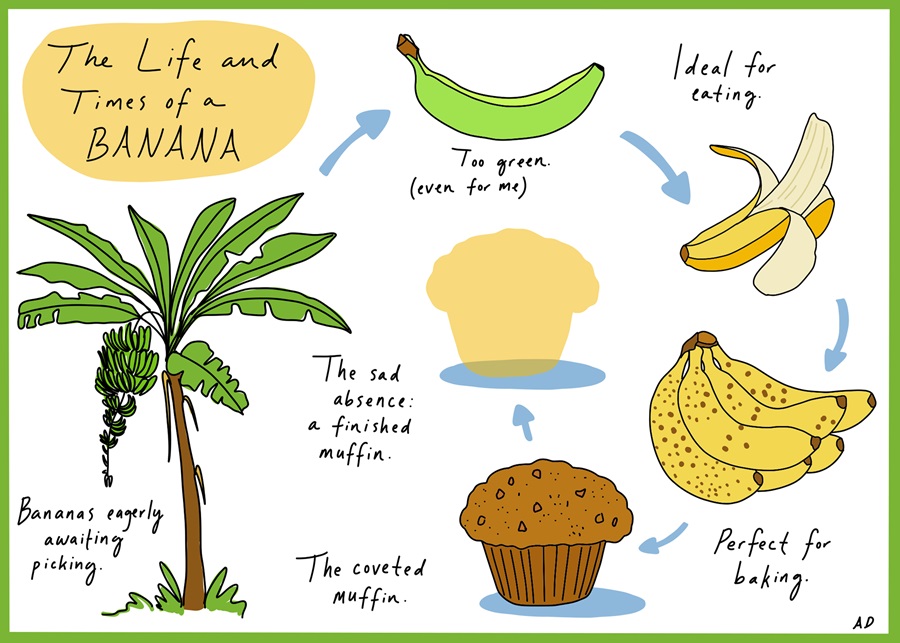The cookbook that first got me interested in baking was Flour by Joanne Chang. I was still a teenager when I brought it home after a delicious lunch at one of her bakeries in Cambridge, also named Flour. That lunch had concluded with a slice of her famous banana bread — a humble but absolutely delicious treat that got people’s attention when Chang was still early in her baking career.
She includes the recipe in the book, where she also tells a story about how, when she was a child, her mother would purchase large bags of overripe bananas — they were cheap that way — and encourage the whole family to eat as many as possible. Creating a banana bread was, she writes, a “protection device” against having to eat so many bananas.
For years, I cooked from Flour — homemade Oreos, blueberry pie, Pop-Tarts from scratch, cornmeal lime cookies, and of course, that memorable banana bread. (Bananas got consumed quickly at my house, and I found myself leaving Post-it notes on banana bunches: “Please save for banana bread!”)

All of Chang’s recipes were written in minute detail, and they often took hours to complete, but the results were always worth it, and I enjoyed the process. I pored over the book and learned how to make brioche and croissants and how to slide butter “down the mountain” — a step called fraisage that results in maximum flakiness of scones and pie crusts. All this led me to many more adventures in the kitchen and gave me the confidence to try any recipe I pleased.
A few years ago, though, my relationship with baking became more complicated. I could no longer eat gluten, and I could handle only a small amount of dairy. That meant pretty much everything in Joanne Chang’s book was off the table, including the banana bread. I tried swapping a gluten-free flour blend for all-purpose flour, but it just wasn’t the same. An important note for all you gluten-free bakers out there: I have found time and time again that swapping out regular flour for a gluten-free blend is never as good as using a recipe that is designed to be gluten free from the start.
Baking this way was a challenge, but I had at least one thing on my side from baking all those complicated Flour recipes. I had confidence in my ability to tackle new recipes, and boy, did I need it. There were many failures, including bread that tasted like salt and nothing else, dry cookies, and a grainy and very disappointing carrot cake.
I tackled quick breads and muffins first, those being on the less complicated side. I perused recipe blogs and compared recipe after recipe. In all my testing, I discovered that a gluten-free, dairy-free quick bread was a lot harder than a muffin. The taste might be the same, but while the loaf would be gummy in the center and sink, even when baked much longer than called for, muffins would puff up into beautiful, satisfying domes.
I’m not sure how many gluten-free muffin recipes I have tried, but eventually I discovered a banana muffin that, while different from the original banana bread from Flour, was just as satisfying. The recipe checked all the boxes: gluten-free, dairy-free, not overly sweet, excellent texture. It was posted on the Ambitious Kitchen blog by Monique Volz, who, I noted, some people referred to as “the muffin queen.”
Over time, I have adjusted those recipes to make them even more to my own liking. The three variations on the classic banana muffin that I’m including here are my own versions of her originals: banana walnut for when you’re in the mood for something classic, banana carrot when you are pining for a carrot cake flavor, and cocoa banana for chocolatey decadence. All the recipes have a healthy blend of flours, use unrefined sugar, and have good protein content, thanks to the use of nut flour. Once you are used to baking these muffins, you can make endless variations of your own. Try zucchini or beet instead of carrots or mix up the spices. If you have some fresh berries, blueberry banana muffins are a lovely version to try.
CLASSIC BANANA WALNUT MUFFINS
Makes 10 muffins
3 overripe bananas
¼ cup maple syrup
2 tsp. vanilla
2 eggs
1 cup oat flour
1 cup almond flour
1 tsp. baking powder
½ tsp. cinnamon
¼ tsp. salt
1/3 cup chopped walnuts
COCOA BANANA MUFFINS
Use the above recipe with these changes:
Add 1 egg, for a total of 3
Use ¾ cup almond flour instead of 1 cup
Add ½ cup cacao powder (or cocoa powder; cacao has more nutrients and more intense chocolate flavor)
Add ¼ cup chocolate chips when adding the walnuts
BANANA CARROT MUFFINS
Makes 12 muffins
3 overripe bananas
2 medium-large carrots, shredded
½ cup coconut sugar
¼ cup extra virgin olive oil
¼ cup almond milk
2 tsp. vanilla
2 large eggs
1½ cups oat flour
1 cup almond flour
2 tsp. cinnamon
2 tsp. baking powder
½ tsp. baking soda
½ tsp. salt
¼ cup chopped pecans
¼ cup raisins (optional)
- Preheat oven to 350° F and place liners in a 12-muffin tin.
- In a large bowl, mash the bananas well, then add the syrup, vanilla, and eggs (if making the carrot version, the carrots, coconut sugar, oil, nut milk, vanilla, and eggs).
- In a medium bowl, sift together the dry ingredients. Fold the dry ingredients into the wet. Do not overmix or the muffins will be dense. Stir in the chopped nuts and the chocolate chips or raisins, if using.
- Divide batter evenly in the muffin cups and bake for 22-27 minutes — until a toothpick inserted into the center of a muffin comes out clean or with a couple of crumbs.
- Let muffins cool in the pan on a wire rack for 10 minutes before removing them from the pan to cool (or to be eaten warm).
- These muffins will keep well for a couple of days stored in an airtight container at room temperature. Reheat for a few minutes in the oven or toaster oven. For longer storage, allow muffins to cool completely and freeze in a freezer-safe container. In theory, these muffins will keep for a few months this way, but mine never last that long.



